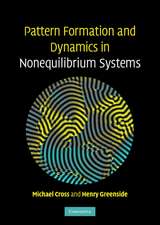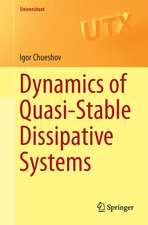Dynamical Systems: Stability, Controllability and Chaotic Behavior
Autor Werner Krabsen Limba Engleză Hardback – 14 sep 2010
| Toate formatele și edițiile | Preț | Express |
|---|---|---|
| Paperback (1) | 556.64 lei 38-45 zile | |
| Springer Berlin, Heidelberg – 13 dec 2014 | 556.64 lei 38-45 zile | |
| Hardback (1) | 644.30 lei 6-8 săpt. | |
| Springer Berlin, Heidelberg – 14 sep 2010 | 644.30 lei 6-8 săpt. |
Preț: 644.30 lei
Preț vechi: 758.01 lei
-15% Nou
Puncte Express: 966
Preț estimativ în valută:
123.28€ • 128.72$ • 102.04£
123.28€ • 128.72$ • 102.04£
Carte tipărită la comandă
Livrare economică 04-18 aprilie
Preluare comenzi: 021 569.72.76
Specificații
ISBN-13: 9783642137211
ISBN-10: 3642137210
Pagini: 250
Ilustrații: X, 238 p.
Dimensiuni: 155 x 235 x 23 mm
Greutate: 0.53 kg
Ediția:2010
Editura: Springer Berlin, Heidelberg
Colecția Springer
Locul publicării:Berlin, Heidelberg, Germany
ISBN-10: 3642137210
Pagini: 250
Ilustrații: X, 238 p.
Dimensiuni: 155 x 235 x 23 mm
Greutate: 0.53 kg
Ediția:2010
Editura: Springer Berlin, Heidelberg
Colecția Springer
Locul publicării:Berlin, Heidelberg, Germany
Public țintă
GraduateCuprins
Uncontrolled Systems.- Controlled Systems.- Chaotic Behavior of Autonomous Time-Discrete Systems.- A Dynamical Method for the Calculation of Nash-Equilibria in n–Person Games.- Optimal Control in Chemotherapy of Cancer.
Recenzii
From the reviews:
“This monograph deals with diverse areas of the theory of dynamical systems, such as stability, controllability and chaotic behavior. The authors’ presentation is precisely limited to these topics, and is self-contained and illustrated by a number of useful examples. The text is easy to read. … This book can be recommended for everybody interested in the mathematical formulation of controllability and chaotic behavior in general.” (Denis Efimov, Mathematical Reviews, Issue 2012 a)
“This book brings together three strands of mathematical thinking, two of them conventionally labelled as ‘dynamical systems’. … Used in conjunction with a standard text in dynamical systems or control theory, this would be an interesting supplement to a course in either discipline.” (Thomas B. Ward, Zentralblatt MATH, Vol. 1207, 2011)
“This monograph deals with diverse areas of the theory of dynamical systems, such as stability, controllability and chaotic behavior. The authors’ presentation is precisely limited to these topics, and is self-contained and illustrated by a number of useful examples. The text is easy to read. … This book can be recommended for everybody interested in the mathematical formulation of controllability and chaotic behavior in general.” (Denis Efimov, Mathematical Reviews, Issue 2012 a)
“This book brings together three strands of mathematical thinking, two of them conventionally labelled as ‘dynamical systems’. … Used in conjunction with a standard text in dynamical systems or control theory, this would be an interesting supplement to a course in either discipline.” (Thomas B. Ward, Zentralblatt MATH, Vol. 1207, 2011)
Notă biografică
Stefan Pickl ist seit 1980 Professor für Operations Research an der Universität der Bundeswehr München. Werner Krabs war Professor am Fachbereich Mathematik an der TU Darmstadt. Er wurde 1999 emeritiert.
Textul de pe ultima copertă
At the end of the nineteenth century Lyapunov and Poincaré developed the so called qualitative theory of differential equations and introduced geometric-topological considerations which have led to the concept of dynamical systems. In its present abstract form this concept goes back to G.D. Birkhoff. This is also the starting point of Chapter 1 of this book in which uncontrolled and controlled time-continuous and time-discrete systems are investigated. Controlled dynamical systems could be considered as dynamical systems in the strong sense, if the controls were incorporated into the state space. We, however, adapt the conventional treatment of controlled systems as in control theory. We are mainly interested in the question of controllability of dynamical systems into equilibrium states. In the non-autonomous time-discrete case we also consider the problem of stabilization. We conclude with chaotic behavior of autonomous time discrete systems and actual real-world applications.
Caracteristici
Interesting and actual topic Unique characterization Relevant related real-world examples (Environmental Management/ Medicine) Includes supplementary material: sn.pub/extras











